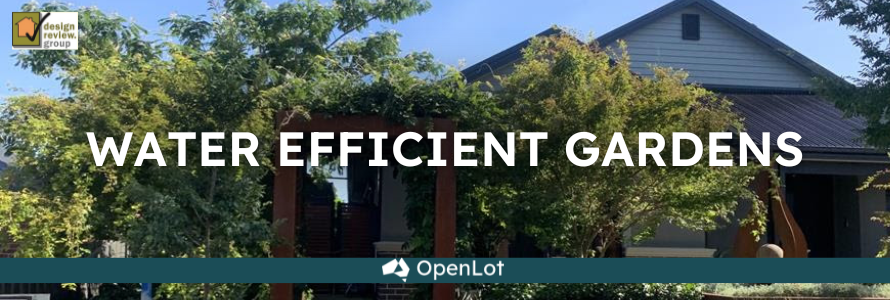
 A water efficient and attractive front yard.
A water efficient and attractive front yard.
Sometimes, a lot owner will create a front yard to be the lowest maintenance possible. It has artificial grass and a few hardy plants; it complies with all the design standards. And it looks ugly!

This front yard adds no kerb appeal to the house or the estate.
This bulletin details how front and back yards can be water efficient, low maintenance, and attractive!
Retaining water falling on the lot
Retaining water on the lot helps to recharge groundwater, reduces the amount of water discharged into the stormwater system, and reduces the peak load to be handled by the stormwater system. Techniques to retain water include: permeable surfaces, rain gardens and water tanks.
Permeable surfaces allow water to soak into the ground and reduces run off into the stormwater system. In many lots the only permeable surfaces are garden beds and the lawn area. The lot’s permeability can be increased if the driveway and paths are made from permeable materials, such as pebbles, gravel, and semi-permeable materials such as bricks and concrete pavers.

Some design codes require a minimum proportion of the front yard to be unpaved. This assists permeability and groundwater recharge.
Rain gardens filter surface water through plants to remove pollutants and nutrients before they enter the stormwater system. This also reduces the peak load on the stormwater system. The plant species used must be able to cope with dry periods between rainfalls, and grow well in sandy soil. Rain gardens are uncommon in residential lots, as most people are unfamiliar with them.
Water tanks can store rainwater for later use in watering gardens. Collecting rainwater also reduces the peak load on the stormwater system. See here for our previous bulletin on storing water on a lot.
Reducing water consumption
About half of all water used in the average Australian suburban lot is used outdoors. The average garden uses 24 litres of water per week per square meter. That’s approximately 840 litres a week, summer and winter, to water the front yard!
Drought tolerant garden beds can be attractive.
What techniques can be used to reduce water consumption outdoors on suburban lots?
Suitable plants: Selecting plants that suit the local climate will reduce water use. Endemic and drought tolerant species will typically use less water. Providing a list of suitable plants for the lot owner to choose from means suitable species are more likely to be used. The Design Review Group can prepare a list of plant species suitable for an estate’s climate and soil type.
Mulch: Mulch can reduce evaporation by up to 70 %, suppress weed growth and protect soil from erosion. The minimum depth required for different types of mulch is shown in the table below.
Organic mulch, such as that made of wood chips, can add nutrients to the soil. However, organic mulch needs to be topped up occasionally, as it decomposes and as fine particles blow away.
Inorganic mulch lasts indefinitely but is more expensive than organic mulch. Inorganic mulch adds glare and heat, so it is prohibited in some estates.

Different types and colours of mulch.
Irrigation: The type and frequency of irrigation will depend on the climate, plant species and the design of the yard. Hoses, sprinklers and irrigation systems are common ways to water suburban gardens. Drip irrigation is the most efficient way to water a plant or garden bed. Pipes can be above or below ground. Below-surface drip irrigation avoids the visual clutter of hoses and pipes, but is harder to check that it is working.
Using non-potable water: Many front yards contain a water tap near the water meter. While its main use is for watering gardens, it is usually dispensing drinking-quality water. Other qualities of water are suitable for watering gardens, namely tank water and recycled water. See here for our previous bulletin on water infrastructure used in residential estates.
During droughts, if public water storage levels are low, restrictions are often placed on watering gardens and washing cars. During droughts, front yards may be displaying yellow grass and dead shrubs. However, during water restrictions, the use of rainwater and recycled water is unrestricted. These additional water sources can keep front gardens and the entire estate looking appealing.

A front yard with drought tolerant plants and minimal paving.
Design standards
Permeable surfaces: Restricting the area of paving in a front yard improves the aesthetics and increases water infiltration.
“At least 60 % of the front yard must be permeable surfaces, such as lawn, garden beds and gravel paths.”
Raingardens: Raingardens slow and filter runoff. A design standard can build awareness and encourage their use.
“Raingardens are encouraged on sloping sites and at the embankment of retaining walls, to filter and slow water before it enters the stormwater system.”
Suitable plants: Requiring water-efficient plants reduces water use. A list of water-efficient plants suitable for the front yard makes choosing suitable species easy for those people who are not expert gardeners.
“At least 70% of the plant species used must be drought tolerant and not need irrigation after establishment.”
Lawn species: For most parts of Australia, a grass species that grows throughout the warm season is more suitable than a cool season grass. Some are also drought-tolerant.
“Tiftuf couch is recommended for lawns to suit the climatic conditions.” (Toowoomba, Queensland)
Mulch: A design standard can require mulch to be a certain material and depth.
“Garden beds must be mulched with organic material such as bark or woodchips at least 80 mm thick.”
Irrigation: Irrigation is generally recommended rather than required.
“Drip irrigation should all be installed to garden beds and lawn.”
Conclusion
The right design standards in an estate’s design code can reduce water use, make the estate more attractive, and reduce the capacity needed in the stormwater system. The design code can require certain elements, or simply inform and educate the lot owners and builders.





